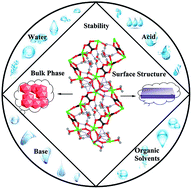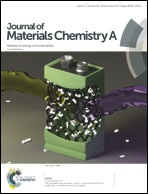A proton-conductive lanthanide oxalatophosphonate framework featuring unique chemical stability: stabilities of bulk phase and surface structure†
Abstract
Metal–organic frameworks (MOFs), a new type of proton conductor, have undergone rapid development due to their available crystal structure and excellent film-forming ability. However, few MOFs for proton conduction have shown good chemical stability in practical applications, mainly tolerance to water, acid, base and organic solvents, and even if they are stable, their stabilities have been roughly confirmed by powder X-ray diffraction (PXRD). Herein, we select a chemically stable lanthanide oxalatophosphonate framework with proton conductivity as an example, and present an effective approach to analyzing and evaluating its chemical stability based on the bulk phase and surface structure. More concretely, its framework integrity, complete ratio (of defects), surface morphology and coordination environment have been characterized by using powder X-ray diffraction (PXRD), thermogravimetric analysis (TGA), inductively coupled plasma optical emission spectrometry (ICP-OES), optical microscopy (OM) and X-ray photoelectron spectroscopy (XPS). The study provides a new insight into understanding chemical stability based on the materials themselves and shows a positive result for MOFs and their related materials in industrial applications.



 Please wait while we load your content...
Please wait while we load your content...